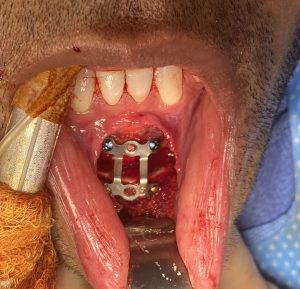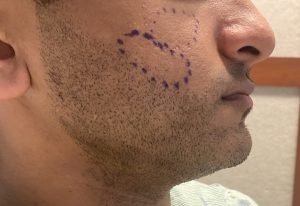The sliding genioplasty is a well known autologous method of chin augmentation. Just like a chin implant the dimensions of the desired chin augmentation effect need to be determined before the surgery not during the surgery. Surgery is an artificial environment in which really seeing the effect of a chin augmentation change can not accurately be seen. The patient is not vertically erect, a breathing tube may be in place which prevents the teeth from coming together properly and, equally importantly, one shouldn’t rely on the surgeon’s perception as to what looks good. (what looks to a surgeon may not look good to a patient)
There are multiple methods of trying to preoperatively determine what the patient desires for their chin augmentation outcome. Computer imaging using the patient’s pictures is the most common, showing different degrees of chin projection changes. This is usually all that is needed most of the time for standard horizontal chin changes. Using a vertical line dropped down from the lower lip and seeing how far out the patient wants the chin projection to be compared to this line provides a very good guide.
Jaw Thrust Maneuver in Sliding Genioplasty Assessment Dr Barry EppleyBut when the chin change is multidimensional, combining horizontal and vertical increases, computer imaging is still useful but needs to be supplemented by the jaw thrust maneuver. When the jaw is thrust forward both a horizontal and vertical chin increase occurs as the condyle slides down the articular eminence of the temporomandibular joint moving the whole jaw down and forward. Having the patient do a jaw thrust with a mirror to where they want the chin to be provides a patient assessment of the vertical change they desire. The actual amount of vertical change can be determined by an interincisal measurement of the distance between the upper and lower front teeth. (plus adding any amount of overbite which is usually present of 1 to 2mms)


Dr. Barry Eppley
World-Renowned Plastic Surgeon



